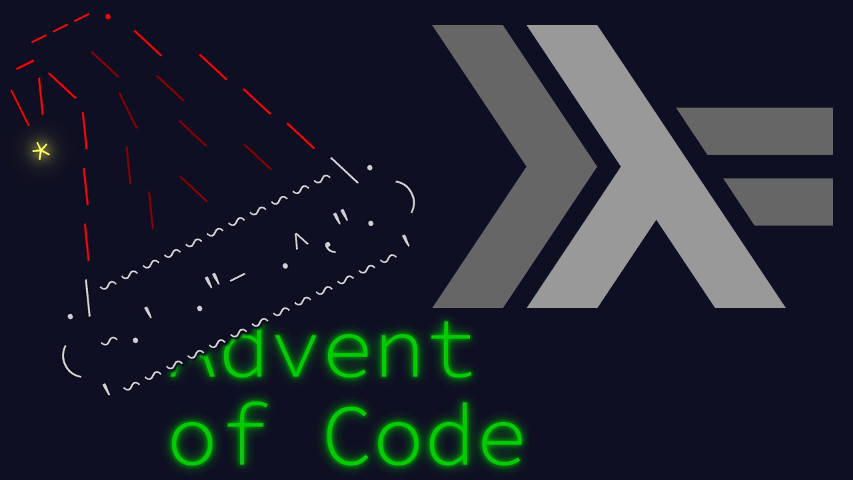Back to 2D grids. In today’s Advent of Code puzzle “RAM RUN”, the input isn’t one, but it becomes a part of the spirit straight away. Let’s resist and not include anything array-related in our imports. Which still come first, this being literate Haskell.
import Control.Arrow ((&&&))
import Control.Lens ((??),(^.),view)
import Control.Monad (forM_,when)
import Data.Equivalence.Monad (runEquivM',equate,equivalent)
import Data.Function (fix)
import Data.Ix (inRange)
import Linear.V2 (V2(V2),_x,_y)
import qualified Data.Set as Set
type V = V2 IntThe input is actually a list of coordinates. We’ll be operating on a prefix of them in part 1, so a list is actually a reasonable structure to hold them in. In addition, we’ll guess the grid size from the contents—this is one of those annoying puzzles where the examples in the statement don’t work with the code that solves the player’s input.1
parse :: String -> ((V,V),[V])
parse = (getBounds &&& id) . map readV . lines where
readV l = V2 (read x) (read y) where (x,_:y) = break (== ',') l
getBounds xys =
( V2 (minimum (view _x <$> xys)) (minimum (view _y <$> xys))
, V2 (maximum (view _x <$> xys)) (maximum (view _y <$> xys)) )Part 1 is our usual shortest path. I’ll implement it with a simple BFS, taking care not to reify the RAM to a 2D array—a symbol of my resistance to the year’s underlying theme.
I have it compute the appropriate prefix length by checking the grid dimensions. Which also validates we got them right.
part1 :: ((V,V),[V]) -> Maybe Int
part1 ((startPos,endPos),ps) = bfs Set.empty [(startPos,0)] where
threshold = case endPos of V2 6 6 -> 12
V2 70 70 -> 1024
corrupted = Set.fromList (take threshold ps)
valid p = inRange (startPos,endPos) p && p `Set.notMember` corrupted
bfs _ [] = Nothing
bfs cl ((p,d):q)
| p == endPos = Just d
| p `Set.member` cl = bfs cl q
| otherwise = bfs cl' (q ++ q') where
cl' = Set.insert p cl
q' = map (,d+1) $
filter (`Set.notMember` cl) $
filter valid (neighborsManhattan p)Part 2 is a weird one. It’s trivial to solve by binary search over prefix length using the code from part 1. (In fact it seems reasonable to even search using linear search.)
That’s what I did at the time, anyway.
But it’s very inefficient for the type of problem this has become. We’re not interested in the shortest path length anymore, merely if one exists. Which is the exact same problem as checking whether a path exist, no matter its length—if one or more exists, one of them will be the shortest, but it won’t change the number of bytes to obstruction.
So this is a mere connectedness problem. A path exists as long as we keep adding bytes to the picture that do not connect the top and right “walls” to the bottom and left ones.
This yields a simple implementation using the
equivalence package.
part2 :: ((V,V),[V]) -> V
part2 ((V2 top left,V2 bottom right),ps0) =
runEquivM' $ flip fix (Set.empty,ps0) $ \loop (corrupted,p:ps) -> do
forM_ (neighborsChebyshev p) $ \p' ->
when (p' `Set.member` corrupted) $ equate (Right p) (Right p')
let topRight = Left True
bottomLeft = Left False
when (p ^. _x == top || p ^. _y == right) $ equate (Right p) topRight
when (p ^. _x == bottom || p ^. _y == left) $ equate (Right p) bottomLeft
equivalent topRight bottomLeft >>= \case
False -> loop (Set.insert p corrupted,ps)
True -> pure pSadly, this is longer than binary search over part 1. Weird moral here.
Let’s add a bit of convoluted support code to make it all work.
neighborsManhattan,neighborsChebyshev :: V -> [V]
neighborsManhattan p = ([(+),(-)] ?? p) <*> [V2 1 0,V2 0 1]
neighborsChebyshev p = map (p +) $ V2 <$> [-1..1] <*> [-1..1]And a trivial wrapper.
main :: IO ()
main = interact $ show . (part1 &&& part2) . parseWe’re all done! See you tomorrow!
The bounds-extracting method isn’t exactly foolproof either, though it works on both the statement example data and my input. I take the min and max of both coordinates of every byte. But there’s no guarantee they’re going to result in the starting and ending position. The only constraints I read from the statement are that the first 1024 bytes don’t block the way, and the full input does. Without the 1024-byte lower bound, the trivial counterexample is an input consisting of a single byte
0,0. But we can still pack a 702 = 4900-byte square in a corner without reaching the right column, for example. FWIW, my input isn’t as long as that.↩︎



